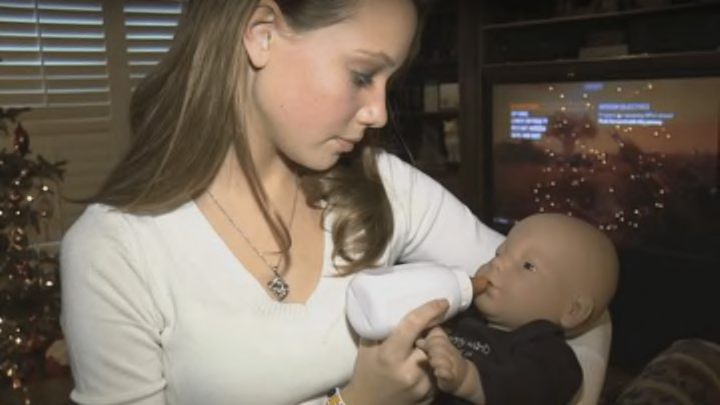Bad news for makers of robot babies: Scientists say educational infant simulators like “Baby Think It Over” don’t reduce, and may actually increase, rates of teen pregnancy. They published their findings in The Lancet.
Bringing home an electronic baby (or a sack of flour, or an empty eggshell with a face drawn on it) has become something of a rite of passage in middle and high schools around the world. The latest baby simulators cry when they need to be fed, comforted, burped, or given a diaper change, while tracking whether or not their “parents” are actually doing these things.
In Australia, infant simulators are part of schools’ Virtual Infant Parenting (VIP) program, which also includes lessons about the sacrifices required by pregnancy (no more keg stands, girls!) and the financial costs of childcare, as well as sessions on healthy relationships, sexual health, and contraception. Teaching the VIP seems like an obvious choice—what better way to scare teenagers straight?
To test the program’s efficacy, researchers recruited 57 schools in Western Australia. Half of the schools were assigned the robotic baby VIP program (1267 students), while the other half continued with a standard health class curriculum (1567 students). Because the study aimed to understand teen pregnancy, the recruited students were all girls between the ages of 13 and 15 when the study began. The researchers also looked at medical records from local hospitals and abortion clinics.
The results were not encouraging. Girls in the control group had a 4 percent risk of becoming pregnant by the time they reached age 20, but those who had taken an infant simulator home were twice as likely (8 percent) to become teen moms. Abortion rates were also higher in the VIP group (9 percent) than in the control group (6 percent).
"Our study shows that the pregnancy prevention programme delivered in Western Australia, which involves an infant simulator, does not reduce the risk of pregnancy in teenage girls,” lead author Sally Brinkman said in a press statement. “In fact, the risk of pregnancy is actually increased compared to girls who didn't take part in the intervention."
Brinkman notes that VIP-like programs are growing in popularity around the world. Infant simulator sessions are currently taught in 89 countries, and that number is only growing. If these programs are in fact working against their creators intentions, that’s a serious cause for concern. A suite of infant simulators can cost tens of thousands of dollars—and most schools don’t have money to spare.
The researchers don’t yet know why the VIP program seems to fail so miserably, but what’s clear, says health expert Julie A Quinlivan of the University of Notre Dame Australia, is that we need to do better. “The cure for teenage pregnancy is more difficult than a magic doll,” she wrote in a commentary in The Lancet. “We have to address both mothers and fathers. Programs need to start in infancy. Investment in vulnerable children is needed to entice these adolescents from the path of premature parenthood into brighter futures. We cannot afford the quick fix, especially when it doesn't work."
Know of something you think we should cover? Email us at tips@mentalfloss.com.
